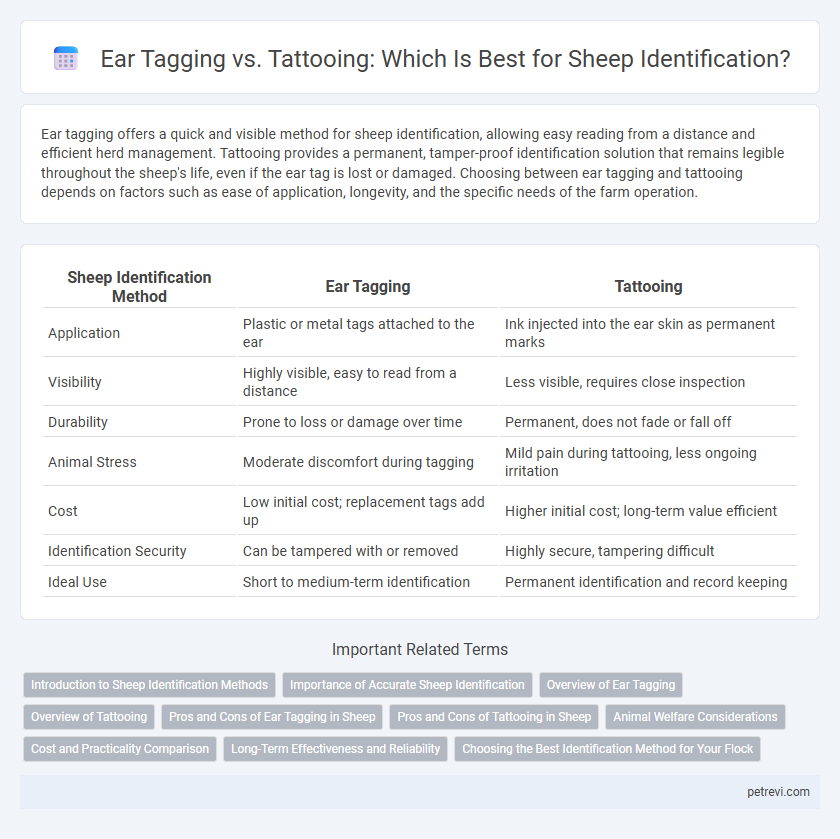Ear tagging offers a quick and visible method for sheep identification, allowing easy reading from a distance and efficient herd management. Tattooing provides a permanent, tamper-proof identification solution that remains legible throughout the sheep's life, even if the ear tag is lost or damaged. Choosing between ear tagging and tattooing depends on factors such as ease of application, longevity, and the specific needs of the farm operation.
Table of Comparison
| Sheep Identification Method | Ear Tagging | Tattooing |
|---|---|---|
| Application | Plastic or metal tags attached to the ear | Ink injected into the ear skin as permanent marks |
| Visibility | Highly visible, easy to read from a distance | Less visible, requires close inspection |
| Durability | Prone to loss or damage over time | Permanent, does not fade or fall off |
| Animal Stress | Moderate discomfort during tagging | Mild pain during tattooing, less ongoing irritation |
| Cost | Low initial cost; replacement tags add up | Higher initial cost; long-term value efficient |
| Identification Security | Can be tampered with or removed | Highly secure, tampering difficult |
| Ideal Use | Short to medium-term identification | Permanent identification and record keeping |
Introduction to Sheep Identification Methods
Sheep identification methods are essential for effective flock management, with ear tagging and tattooing being the most common techniques. Ear tagging offers a quick, visible, and easily readable option for daily management and regulatory compliance, while tattooing provides a permanent and tamper-resistant form of identification. Both methods support traceability, health monitoring, and breeding record accuracy within sheep production systems.
Importance of Accurate Sheep Identification
Accurate sheep identification is essential for effective flock management, disease control, and traceability in the livestock industry. Ear tagging offers a visible, quick method for individual recognition, while tattooing provides a permanent and tamper-resistant alternative, especially useful in harsh environmental conditions. Both techniques contribute to maintaining animal health records, enhancing biosecurity, and complying with regulatory requirements.
Overview of Ear Tagging
Ear tagging in sheep identification offers a practical and efficient method for tracking individual animals within a flock, utilizing durable plastic or metal tags attached to the ear. This technique enables rapid visual identification and data collection essential for herd management, breeding programs, and health monitoring. Commonly used tags are color-coded and numbered, supporting regulatory compliance and record-keeping in sheep farming operations.
Overview of Tattooing
Tattooing in sheep identification involves imprinting a permanent code or number inside the animal's ear using a special tattoo gun and ink, ensuring a reliable and tamper-proof method for tracking individual animals. This technique is widely recognized for its durability, as the tattoo remains visible throughout the sheep's lifetime, providing consistent identification without risk of tag loss. Tattooing is especially beneficial in large flocks or research settings where long-term, unaltered identification is critical for management and record-keeping.
Pros and Cons of Ear Tagging in Sheep
Ear tagging in sheep offers quick application and ease of visual identification, improving flock management and traceability. However, tags can be lost or damaged, leading to potential misidentification and the need for re-tagging. The risk of ear infections or damage during tagging also necessitates proper hygiene and handling to ensure animal welfare.
Pros and Cons of Tattooing in Sheep
Tattooing in sheep offers a permanent and tamper-resistant method for identification, ensuring durability even in harsh environmental conditions. However, the process can be painful and stressful for the animals, requiring proper restraint and experienced handlers to minimize distress. Unlike ear tagging, tattoos may be harder to read from a distance and can fade over time, necessitating periodic maintenance for clarity.
Animal Welfare Considerations
Ear tagging offers a quicker, less invasive method of sheep identification, reducing stress and pain compared to tattooing, which involves piercing the skin and can cause discomfort. Properly applied ear tags minimize infection risks, while tattooing requires repeated restraint, potentially increasing distress. Choosing ear tagging aligns better with animal welfare standards by promoting quicker recovery and less handling time.
Cost and Practicality Comparison
Ear tagging for sheep identification offers a lower initial cost and easier application compared to tattooing, making it a practical choice for large flocks. Tattooing involves higher upfront expenses due to specialized equipment and labor but provides a permanent, tamper-proof ID that is less likely to be lost or damaged. Cost-effectiveness depends on flock size and management needs, with ear tags favored for quick application and tattoos preferred for long-term durability.
Long-Term Effectiveness and Reliability
Ear tagging provides a highly visible and easily scannable identification method for sheep, but tags are susceptible to loss, damage, and fading over time, reducing long-term reliability. Tattooing offers a permanent identification solution that remains legible throughout the sheep's life, unaffected by environmental factors or physical wear, ensuring consistent traceability. Combining both methods enhances long-term effectiveness by maintaining visual identification and securing permanent records for livestock management and regulatory compliance.
Choosing the Best Identification Method for Your Flock
Ear tagging offers quick, visible identification ideal for large flocks, while tattooing provides a permanent, tamper-resistant option well-suited for long-term record keeping. Consider factors such as flock size, ease of application, and environmental conditions when selecting the best method for your sheep. Integrating both techniques can enhance identification accuracy and traceability in diverse management systems.
Ear Tagging vs Tattooing for Sheep Identification Infographic

 petrevi.com
petrevi.com